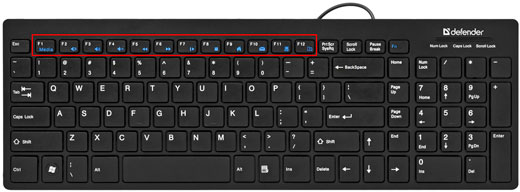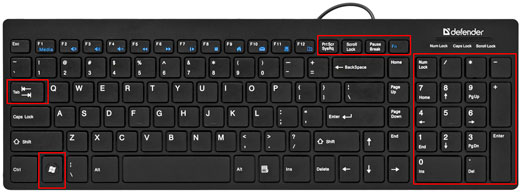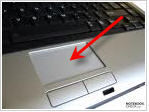What do the function keys of a laptop mean. Keys on a laptop
![]()
Hello everyone, my dear friends of my blog. Today we will have a simple topic, but nevertheless very interesting and important. This is because I want to tell you about the purpose of the keys on the keyboard of a computer or laptop. Yes, of course, you can say that I already know this. But I can assure you that many do not know even half of these appointments. In general, I will not procrastinate. Here is my visual aid.
Key assignment F1-F12

- F1- In most applications, this button is responsible for calling up the help of this program. Well, if the program is not open, then Windows help is called.
- F2- "Rename" function. That is, you just need to select the file and press this key.
- F3- In most programs, including Windows Explorer, the search string is called. That is, if you need to find a document on a computer, or find text in a browser, you can use this function button. If in a Word you use it in conjunction with SHIFT key, you can make uppercase letters lowercase and vice versa.
- F4- If you take Word, then this button is designed to repeat the last action. And of course, many of you know that if you simultaneously press ALT+F4, this will close the application.
- F5- In any Internet browser, the page is updated. For Word, this button enables the "Find and Replace" function. In notepad, pressing this key will insert the current date and time. In Power Point, by clicking on this button, a slide show starts. Well, if you use the environment Total Commander, then you have activated copying. Just a multifunction key.
- F6- In the browser (except Opera), the cursor automatically enters the address bar, while fully highlighting the address itself. Well, in Total Commander, the “Move” function works.
- F7- IN Word document spell check is in progress. In Total Commander you create a new directory, i.e. a folder.
- F8- In excel, the key expansion mode is enabled. IN Opera browser stands out address bar. In the Total Commander, thanks to this button, you can delete a file.
- F9- Update fields in Word
- F10- In the explorer, it calls up hints about hot keys for calling functions. In many programs, this key means to open the menu. And if you use this button with SHIFT held down, then pressing is simulated right button mice.
- F11- Thanks to this insidious key, browsers implement . Oh, how much panic there was because of her). Well, in Excel, you create a new sheet.
- F12- Calling the web developer mode in browsers. And in the Word, you can call the "Save as ..." function.
Other keys
Of course, in addition to the top buttons, there are others, the purpose of which is also not known to everyone. Therefore, below I will present you with a description of the functions of other keys.

Tab- In Word documents or other text editors this key will allow you to retreat several positions at once, unlike the space bar, which moves only one position. Among other things, there is text alignment. Well, another important feature that not everyone knows about is that when filling out various forms (no matter where, in browsers or programs), you can switch between fields.
Numlock- button lock mode. By pressing this button you will be able to write numbers on additional keyboard, but as soon as you press it again, the set of numbers is blocked and the mode of additional functions indicated on each button (arrows, Pg Up, Pg Dn, Home, End) is activated.
Home and End— Move to the beginning or end of the document.
Pg Up and Pg Dn— Move one screen (page) up or down.
Win- Well, I won’t tell anything about the merits of this key here, since I devoted it to this. Be sure to read and use if you have not yet reached this point.
fn- this key is found only on laptops, and it is intended to expand the functionality of the F1-F12 buttons, as well as those that are in the same row with them (Pause, Del, Home, etc.). You can see for yourself that on this row of keys, in addition to their names, various drawings are applied. It is these functions that will be activated if you hold down FN, and then press one of the function keys. For example, I have a crossed-out touchpad drawn on F6. This means that if I hold Fn and press F6, then I will disable the touchpad on my laptop.
scroll lock- scroll change key. If the mode is enabled, then the cursors perform the functions of scrolling the screen in all directions, and if disabled, the cursor position function is activated.
PrtSc (Print Screen)- just in case, I’ll write it in, but I think that many people know what this key is for. Quite right, dear friends. With it, we can take a screenshot, i.e. screenshot. You can learn more about screenshots. And by the way, I recommend that you immediately install a program like LightShot or Joxi for these purposes.
Well, I think that it makes no sense to write about the rest of the keys, because everyone knows what a space, Shift, Ctrl and Backspace are. Well, in general, if you skillfully use all these buttons, then you will definitely. So don't neglect it.
Therefore, on this cheerful note, I end my article. I hope that it was interesting for you and helped you discover the assignment of computer keyboard keys in a new light. Well, I wish you good luck. And of course, don't forget to subscribe. Good luck to you. Bye Bye!
Minicompetition
For a long time I have not held mini-competitions as part of my own, so I suggest you score a few points.
The point is this. In the comments, you should write various key combinations that involve the F1-F12 buttons and explain their meaning. For example ALT + F4 - Closing the application. Those combinations that are present in the article will not be counted. For each combination you will receive 5 points, but no more than 8 are accepted. Those. maximum for the contest you can earn 40 points.
Hello, friends! If you look closely at keys on a laptop, you can see that some of them, in addition to the usual letters, numbers and symbols, have icons that many do not understand. Usually these icons are made in a different color from the main symbols.
In addition, a laptop usually has a separate key on which two symbols are indicated - “Fn”, these symbols can also be in a frame. The Fn key and the icons that I will talk about today in this article are usually painted in the same color. As you probably already guessed, these buttons are connected to each other.
By the way, if you are interested, you can read articles about Windows 7 Hot Keys and Windows XP Hot Keys.
The "Fn" button itself is called functional, which means that it activates additional functions of the laptop. The combination "Fn", respectively, is an abbreviation for the word Function and reads "Fankshin". Pressing this button in combination with keys with additional icons (blue in my case) activates functions whose meaning corresponds to the depicted symbol.
Further in the article I will tell you in detail what kind of additional function this or that symbol assumes. It is important to understand that in different models laptops, functional symbols can be located on different keys, then we will consider additional functions based on them, because they do not differ much from each other on different laptop models.
keys on a laptop, which are designed as additional functions, help users to perform operations quickly, such as when the volume needs to be turned off or turned down.
The Fn key on a laptop looks like this:
Pressing "Fn" and
Puts the computer into "sleep" mode or returns it to a working state from "sleep".
Pressing "Fn" and Enable / Disable network adapter wireless network wifi laptop.
Pressing "Fn" and Decrease the brightness on the monitor.
Pressing "Fn" and Increase the brightness on the monitor.
For a laptop, this feature can be especially relevant, since when the brightness is reduced, power consumption is significantly reduced, that is, in order to increase battery life, you can sacrifice a little display brightness.
Pressing Fn and Turns off/on the screen backlight(s). On some models, it also stretches the image to fill the screen when running at low resolutions.
Pressing "Fn" and Changes the display mode. Useful when using an external display, that is, if an additional monitor / projector is connected to your laptop. The modes are as follows: simultaneously on the laptop display and an external display, or only on one of them.
Pressing "Fn" and Turn off / on the touchpad (touchpad) is a touch pad used as a replacement for a mouse in a laptop. On some models, a separate dedicated button can perform the same function, usually near the touchpad itself.
Below is a photo of the touchpad.
Pressing "Fn" and
Turn off the volume.
Pressing "Fn" and
Pressing "Fn" and
Pressing "Fn" and Turn on / off the small numeric keypad mode, usually that this mode turned on, reports one of the LEDs - an indicator on the laptop panel. The question arises: “What can turn on if there is no such add-on on the laptop keyboard?”. But, looking more closely, we see that on some keys in blue, not pictures are applied, but numbers from 0 to 9, a dash and an asterisk, which just correspond to the symbols of the small number of the keyboard. It should be noted that in some models, if the size allows, there may be a classic small numeric keypad, located on the right, on their individual buttons. In this case, to use it, it is enough to turn on the NumPad mode (NumLk) and just press the keys.
Pressing "Fn" and Turn on / off the screen move mode. Today this function is not used very widely and in different applications the result of enabling this mode may be different. In MSExcel, you can classically see the meaning of using this mode. When the ScrollLock mode is off, the cursor keys (arrows) will move the cursor around the table grid, and when it is on, the screen will move, the cursor will remain in the same cell.
Pressing "Fn" and Number 7 with NumLk on.
Pressing "Fn" and Number 8 with NumLk on.
Pressing "Fn" and Number 9 with NumLk on.
Pressing "Fn" and the "/" symbol when NumLk is on.
Pressing "Fn" and Number 4 with NumLk on.
Pressing "Fn" and Number 5 with NumLk on.
Pressing "Fn" and Number 6 with NumLk on.
Pressing "Fn" and the "*" symbol when NumLk is on.
Pressing "Fn" and Number 1 with NumLk on.
Pressing "Fn" and Number 2 with NumLk on.
Pressing "Fn" and Number 3 with NumLk on.
Pressing "Fn" and the "-" symbol when NumLk is on.
Pressing "Fn" and Number 0 with NumLk on.
Pressing "Fn" and the "Point" symbol with NumLk on.
Pressing "Fn" and the "+" sign while NumLk mode is on.
Pressing "Fn" and one of the following buttons:
Manages your music player. By default, this group of buttons controls tracks in Windows program media player, but if desired, they can be reconfigured to another player, such as Winamp.
Pressing "Fn" and Turns on / off the webcam.
Pressing "Fn" and Turns the "Splendid Video Intelligent Technology" feature on or off. This technology enhances the laptop screen display (OSD) by offering a variety of modes that are adapted to specific working conditions. You can see the current mode on the screen (OSD).
You must understand that there may be other icons on the keyboard, and also similar to those discussed above in one of the keyboards. They differ because keyboards are made by different manufacturers.
Now let's tell you what icons you can still meet.
Pressing "Fn" and Performs the function of the Home key, that is, moves the cursor to the beginning of the document, web page or folder, depending on which program you are working in.
Pressing "Fn" and will perform the same action as the previous key, only moves the cursor to the end.
Pressing "Fn" and Calls up the help window.
Pressing "Fn" and Brings up the energy settings dialog box.
Pressing "Fn" and Turns on / off the BlueTooth function.
Pressing "Fn" and activates the receipt of mail in your mail client (a program for receiving Internet mail). To use this function mail program must be configured accordingly.
Pressing "Fn" and Connects the computer to the Internet. To use this feature, your computer must have special programs, which are supplied with the laptop, if it has such a key.
Pressing "Fn" and
The Pause/Break keys are almost never used. They are designed to suspend a process on a computer.
Pressing "Fn" and Enlarge / reduce the image.
Pressing "Fn" and Decrease / increase the brightness on the monitor.
Pressing "Fn" and
Decrease/increase volume.
Press "Fn" and page up/down.
If your laptop has buttons with symbols of additional functions that were not mentioned in the article, then please write about it in the comments to the article, and I will definitely supplement the description with them. http://useroff.com/klavishi-na-noutbuke.html
If you look closely at the laptop keys, you will notice that on some of them, in addition to the usual letters, numbers and symbols, there are icons that many do not understand. Usually these icons are made in a different color from the main symbols on the keys. In addition, a laptop usually has a separate key on which two symbols are indicated - “Fn”, these symbols can also be in a frame. The Fn key and the icons that I will talk about today in this article are usually painted in the same color. These buttons are linked to each other.
The "Fn" button itself is called functional, which means that it activates additional functions of the laptop. The combination "Fn", respectively, is an abbreviation for the word Function and reads "Fankshin". Pressing this button in combination with keys with additional icons (blue in my case) activates functions whose meaning corresponds to the depicted symbol.
keys on a laptop, which are designed as additional functions, help users to perform operations quickly, such as when the volume needs to be turned off or turned down.
The Fn key on a laptop looks like this:
Pressing "Fn" and Puts the computer into "sleep" mode or returns it to a working state from "sleep".
Pressing "Fn" and Enable / Disable the wireless network adapter wifi networks laptop.
Pressing "Fn" and Decrease the brightness on the monitor.
Pressing "Fn" and Increase brightness on the monitor.
For a laptop, this feature can be especially relevant, since when the brightness is reduced, power consumption is significantly reduced, that is, in order to increase battery life, you can sacrifice a little display brightness.
Pressing Fn and Turns off/on the screen backlight(s). On some models, it also stretches the image to fill the screen when running at low resolutions.
Pressing "Fn" and Changes the display mode. Useful when using an external display, that is, if an additional monitor / projector is connected to your laptop. The modes are as follows: simultaneously on the laptop display and an external display, or only on one of them.
 Pressing "Fn" and Turn off / on the touchpad (touchpad) - a touch pad used as a replacement for a mouse in a laptop. On some models, a separate dedicated button can perform the same function, usually near the touchpad itself.
Pressing "Fn" and Turn off / on the touchpad (touchpad) - a touch pad used as a replacement for a mouse in a laptop. On some models, a separate dedicated button can perform the same function, usually near the touchpad itself.
Pressing "Fn" and turn off the volume.
Pressing "Fn" and Volume down.
Pressing "Fn" and Volume Up.
Pressing "Fn" and Enable / disable the small numeric keypad mode, usually one of the LEDs - an indicator on the laptop panel - indicates that this mode is enabled. The question arises: “What can turn on if there is no such add-on on the laptop keyboard?”. But, looking more closely, we see that on some keys in blue, not pictures are applied, but numbers from 0 to 9, a dash and an asterisk, which just correspond to the symbols of the small number of the keyboard. It should be noted that in some models, if the size allows, there may be a classic small numeric keypad located on the right, on its own separate buttons. In this case, to use it, it is enough to turn on the NumPad (NumLk) mode and just press the keys.
Pressing "Fn" and Turn on / off the screen movement mode. Today this function is not used very widely and in different applications the result of enabling this mode may be different. In MSExcel, you can classically see the meaning of using this mode. When the ScrollLock mode is off, the cursor keys (arrows) will move the cursor around the table grid, and when it is on, the screen will move, the cursor will remain in the same cell.
Pressing "Fn" and Number 7 with NumLk on.
Pressing "Fn" and Number 8 with NumLk on.
Pressing "Fn" and Number 9 with NumLk on.
Pressing "Fn" and the Symbol "/" with NumLk on.
Pressing "Fn" and Number 4 with NumLk on.
Pressing "Fn" and Number 5 with NumLk on.
Pressing "Fn" and Number 6 with NumLk on.
Pressing "Fn" and the Symbol "*" with NumLk on.
Pressing "Fn" and Number 1 with NumLk on.
Pressing "Fn" and Number 2 with NumLk on.
Pressing "Fn" and Number 3 with NumLk on.
 How to invite VKontakte to a group Invitation to events and analytics
How to invite VKontakte to a group Invitation to events and analytics Alla Dovlatova: biography, personal life, family, husband, children, pregnancy - photo How many children does Alla Dovlatova have?
Alla Dovlatova: biography, personal life, family, husband, children, pregnancy - photo How many children does Alla Dovlatova have? Download mod to craft diamonds from the ground
Download mod to craft diamonds from the ground